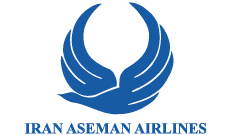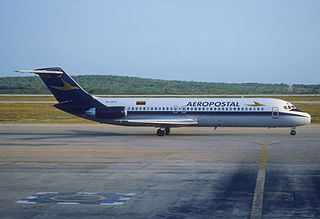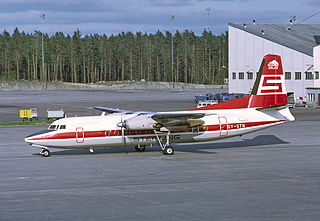
Indian Airlines was a division of Air India Limited. It was based in Delhi and focused primarily on domestic routes, along with several international services to neighbouring countries in Asia. It was a division of Air India Limited after merger of eight pre-Independence domestic airlines.

The Fokker F27 Friendship is a turboprop airliner developed and manufactured by the Dutch aircraft manufacturer Fokker. It is the most numerous post-war aircraft manufactured in the Netherlands; the F27 was also one of the most successful European airliners of its era.

Air Gabon was the national, state-owned airline of Gabon, operating out of Libreville International Airport to a variety of destinations across western and southern Africa, as well as to Europe, South America, and the Middle East. Founded in 1951, the airline went bankrupt in 2006.

The Antonov An-26 is a twin-engined turboprop civilian and military transport aircraft, designed and produced in the Soviet Union from 1969 to 1986.

Iran Aseman Airlines is the third-largest Iranian airline headquartered in Tehran. It operates scheduled domestic passenger services and regional international services.

Mehrabad International Airport, is an international airport serving Tehran, the capital city of Iran. Prior to the construction of the larger Imam Khomeini International Airport in 2007, Mehrabad was Tehran's primary airport in both international and domestic traffic, but now serves only domestic flights. Despite this, in 2016 Mehrabad Airport was the busiest airport in Iran in terms of passengers, handling 16,678,351 passengers in total. The airport is also used by the Government of Iran and is one of the bases of the Iranian Air Force.

Rio-Sul Serviços Aéreos Regionais S/A was a regional airline headquartered in Rio de Janeiro, Brazil, operating scheduled services to southern Brazil. Its main base was Congonhas Domestic Airport (CGH), São Paulo, with hubs at Porto Alegre Airport (POA) and Santos Dumont Airport, Rio de Janeiro.

Pacific Air Lines Flight 773 was a Fairchild F27A Friendship airliner that crashed on May 7, 1964, near Danville, California, a suburb east of Oakland. The Thursday morning crash was most likely the first instance in the United States of an airliner's pilots being shot by a passenger as part of a mass murder–suicide. Francisco Paula Gonzales, 27, shot both pilots before turning the gun on himself, causing the plane to crash, killing all 44 aboard. As of May 2021, the crash of Flight 773 remains the worst incident of mass murder in modern California history, one death more than the subsequent Pacific Southwest Airlines Flight 1771 hijacking.
Compagnie Africaine d'Aviation, renamed FlyCAA in 2013, is a regional airline from the Democratic Republic of the Congo, based at N'djili Airport in Kinshasa. It offers an extensive network of domestic scheduled passenger flights, as well as cargo flights. Due to safety and security concerns, CAA has been included in the list of air carriers banned in the European Union, along with many other airlines from the Congo.

TAM Transportes Aéreos Regionais Flight 402 was a scheduled domestic flight from São Paulo–Congonhas International Airport in São Paulo, Brazil to Recife International Airport in Recife via Santos Dumont Airport in Rio de Janeiro. On 31 October 1996, at 8:27 (UTC-2), the starboard engine of the Fokker 100 operating the route reversed thrust while the aircraft was climbing away from the runway at Congonhas. The aircraft stalled and rolled beyond control to the right, then struck two buildings and crashed into several houses in a heavily populated area only 25 seconds after takeoff. All 95 people on board were killed, as well as another 4 on the ground. It is the fourth deadliest accident in Brazilian aviation history, the second at the time. It is also the deadliest aviation accident involving a Fokker 100.

As of July 2020, a total of 61 Boeing 747 aircraft, or just under 4% of the total number of 747s built, first flown commercially in 1970, have been involved in accidents and incidents resulting in a hull loss, meaning that the aircraft was either destroyed or damaged beyond economical repair. Of the 61 Boeing 747 aircraft losses, 32 resulted in no loss of life; in one, a hostage was murdered; and in one, a terrorist died. Some of the aircraft that were declared damaged beyond economical repair were older 747s that sustained relatively minor damage. Had these planes been newer, repairing them might have been economically viable, although with the 747's increasing obsolescence, this is becoming less common. Some 747s have been involved in accidents resulting in the highest death toll of any civil aviation accident, the highest death toll of any single airplane accident, and the highest death toll of a midair collision. As with most airliner accidents, the root of cause(s) in these incidents involved a confluence of multiple factors that rarely could be ascribed to flaws with the 747's design or its flying characteristics.

Aeropostal Alas de Venezuela Flight 108 was a short-haul flight from La Chinita International Airport in Maracaibo, Venezuela to Santa Barbara Ed-L Delicias Airport that crashed on March 5, 1991.

Iran Aseman Airlines Flight 746 was a Fokker F-28 flight of Iran Aseman Airlines operating on the Isfahan–Tehran route in Iran. The flight crashed near the town of Natanz on October 12, 1994, killing all the passengers and crew members.

Laoag International Airlines Flight 585 was a scheduled flight operated by Laoag International Airlines from Manila to Basco, Philippines via Laoag. On November 11, 2002, the Fokker F-27 Friendship crashed into Manila Bay shortly after takeoff from Ninoy Aquino International Airport. Of the 34 passengers and crew on board, 15 survived.

Daallo Airlines Flight 159 was a scheduled international passenger flight operated by Somali-owned Daallo Airlines. On 2 February 2016, an explosion occurred on board the aircraft 20 minutes after it took off from Mogadishu. The aircraft was able to return to the airport safely, with one fatality reported. A subsequent investigation indicated that the explosion was caused by a bomb, detonated in a suicide attack. The Islamist militant group Al-Shabaab later claimed responsibility for the bombing. A total of ten people were convicted in relation to the plot.














